Fly-Ash Evaluation as Potential EOL Material Replacement of Cement in Pastes: Morpho-Structural and Physico-Chemical Properties Assessment
Abstract
:1. Introduction
2. Experimental
2.1. Materials and Methods
2.2. Characterization
3. Results and Discussion
3.1. Thermal Power Plant Ash Sample Characterization
3.2. The In-Situ Evaluation of Cement Pastes with SCM
3.3. Flow Properties of SCM-Containing Pastes at Different Curing Intervals
4. Conclusions
Author Contributions
Funding
Institutional Review Board Statement
Informed Consent Statement
Data Availability Statement
Conflicts of Interest
References
- Adesina, A. Recent advances in the concrete industry to reduce its carbon dioxide emissions. Environ. Chall. 2020, 1, 100004. [Google Scholar] [CrossRef]
- Ekinci, E.; Kazancoglu, Y.; Mangla, S.K. Using system dynamics to assess the environmental management of cement industry in streaming data context. Sci. Total Environ. 2020, 715, 136948. [Google Scholar] [CrossRef] [PubMed]
- Mosquera, M.J.; Silva, B.; Prieto, B.; Ruiz-Herrera, E. Addition of cement to lime-based mortars: Effect on pore structure and vapor transport. Cem. Concr. Res. 2006, 36, 1635–1642. [Google Scholar] [CrossRef]
- Bye, G.C. Portland Cement: Composition, Production and Properties; Thomas Telford: London, UK, 1999. [Google Scholar]
- Soroka, I. Portland Cement Paste and Concrete; Macmillan International Higher Education: London, UK, 1979; ISBN 0333242319 9780333242315. [Google Scholar]
- Snellings, R.; Horckmans, L.; Van Bunderen, C.; Vandewalle, L.; Cizer, Ö. Flash-calcined dredging sediment blended cements: Effect on cement hydration and properties. Mater. Struct. 2017, 50, 241. [Google Scholar] [CrossRef]
- Sivakrishna, A.; Adesina, A.; Awoyera, P.; Kumar, K.R. Green concrete: A review of recent developments. Mater. Today Proc. 2020, 27, 54–58. [Google Scholar] [CrossRef]
- Mehta, P.K. Advancements in concrete technology. Concr. Int. 1999, 21, 69–76. [Google Scholar]
- Kampa, M.; Castanas, E. Human health effects of air pollution. Environ. Pollut. 2008, 151, 362–367. [Google Scholar] [CrossRef]
- Pregger, T.; Friedrich, R. Effective pollutant emission heights for atmospheric transport modelling based on real-world information. Environ. Pollut. 2009, 157, 552–560. [Google Scholar] [CrossRef]
- Baccarelli, A.A.; Zheng, Y.; Zhang, X.; Chang, D.; Liu, L.; Wolf, K.R.; Zhang, Z.; McCracken, J.P.; Díaz, A.; Bertazzi, P.A. Air pollution exposure and lung function in highly exposed subjects in Beijing, China: A repeated-measure study. Part. Fibre Toxicol. 2014, 11, 51. [Google Scholar] [CrossRef] [Green Version]
- Collivignarelli, M.C.; Cillari, G.; Ricciardi, P.; Miino, M.C.; Torretta, V.; Rada, E.C.; Abbà, A. The Production of Sustainable Concrete with the Use of Alternative Aggregates: A Review. Sustainability 2020, 12, 7903. [Google Scholar] [CrossRef]
- Medina, G.; Del Bosque, I.S.; Frías, M.; De Rojas, M.S.; Medina, C. Granite quarry waste as a future eco-efficient supplementary cementitious material (SCM): Scientific and technical considerations. J. Clean. Prod. 2017, 148, 467–476. [Google Scholar] [CrossRef]
- Hossain, M.; Karim, M.; Hasan, M.; Hossain, M.; Zain, M. Durability of mortar and concrete made up of pozzolans as a partial replacement of cement: A review. Constr. Build. Mater. 2016, 116, 128–140. [Google Scholar] [CrossRef]
- Mo, K.H.; Ling, T.-C.; Alengaram, U.J.; Yap, S.P.; Yuen, C.W. Overview of supplementary cementitious materials usage in lightweight aggregate concrete. Constr. Build. Mater. 2017, 139, 403–418. [Google Scholar] [CrossRef]
- Abbas, S.; Sharif, A.; Ahmed, A.; Abbass, W.; Shaukat, S. Prospective of sugarcane bagasse ash for controlling the alkali-silica reaction in concrete incorporating reactive aggregates. Struct. Concr. 2020, 21, 781–793. [Google Scholar] [CrossRef]
- Mikhailenko, P.; Cassagnabère, F.; Emam, A.; Lachemi, M. Influence of physico-chemical characteristics on the carbonation of cement paste at high replacement rates of metakaolin. Constr. Build. Mater. 2018, 158, 164–172. [Google Scholar] [CrossRef]
- Nicoara, A.I.; Stoica, A.E.; Vrabec, M.; Šmuc Rogan, N.; Sturm, S.; Ow-Yang, C.; Gulgun, M.A.; Bundur, Z.B.; Ciuca, I.; Vasile, B.S. End-of-life materials used as supplementary cementitious materials in the concrete industry. Materials 2020, 13, 1954. [Google Scholar] [CrossRef] [Green Version]
- Vargas, J.; Halog, A. Effective carbon emission reductions from using upgraded fly ash in the cement industry. J. Clean. Prod. 2015, 103, 948–959. [Google Scholar] [CrossRef] [Green Version]
- Rastogi, A.; Paul, V.K. A critical review of the potential for fly ash utilisation in construction-specific applications in India. Environ. Res. Eng. Manag. 2020, 76, 65–75. [Google Scholar] [CrossRef]
- Ramachandran, V. Alkali-aggregate expansion inhibiting admixtures. Cem. Concr. Compos. 1998, 20, 149–161. [Google Scholar] [CrossRef]
- Wang, S.; Baxter, L.; Fonseca, F. Biomass fly ash in concrete: SEM, EDX and ESEM analysis. Fuel 2008, 87, 372–379. [Google Scholar] [CrossRef]
- Taylor, H.F. Cement Chemistry; Thomas Telford: London, UK, 1997; Volume 2. [Google Scholar]
- Manz, O.E. Coal fly ash: A retrospective and future look. Fuel 1999, 78, 133–136. [Google Scholar] [CrossRef]
- Washa, G.; Witney, N. Strength and durability of concrete containing Chicago fly ash. J. Proc. 1953, 49, 701–712. [Google Scholar]
- Samarin, A.; Munn, R.; Ashby, J. The use of fly ash in concrete-Australian experience. Spec. Publ. 1983, 79, 143–172. [Google Scholar]
- Costa, U.; Massazza, F. Some properties of pozzolanic cements containing fly ashes. Spec. Publ. 1983, 79, 235–254. [Google Scholar]
- Pasko, T.; Larson, T. Some Statistical Analyses of the Strength and Durability of Fly Ash Concrete. Proc. Am. Soc. Test. Mater. 1962, 62, 1054–1067. [Google Scholar]
- ASTM C 618-03; Standard Specification for coal Fly-Ash and Raw or Calcined Natural Pozzolan for Use in Concrete, Materials, Concrete and Aggregates. Volume 04.02. ASTM International: West Conshohocken, PA, USA, 2003. Available online: www.astm.org (accessed on 19 March 2022).
- Wang, S.; Llamazos, E.; Baxter, L.; Fonseca, F. Durability of biomass fly ash concrete: Freezing and thawing and rapid chloride permeability tests. Fuel 2008, 87, 359–364. [Google Scholar] [CrossRef]
- Pedersen, K.H.; Jensen, A.D.; Skjøth-Rasmussen, M.S.; Dam-Johansen, K. A review of the interference of carbon containing fly ash with air entrainment in concrete. Prog. Energy Combust. Sci. 2008, 34, 135–154. [Google Scholar] [CrossRef]
- Hewlett, P.; Liska, M. (Eds.) Lea's Chemistry of Cement and Concrete; Butterworth-Heinemann: Oxford, UK, 2019. [Google Scholar]
- Chindaprasirt, P.; Buapa, N.; Cao, H. Mixed cement containing fly ash for masonry and plastering work. Constr. Build. Mater. 2005, 19, 612–618. [Google Scholar] [CrossRef]
- Duxson, P.; Provis, J.L.; Lukey, G.C.; Van Deventer, J.S. The role of inorganic polymer technology in the development of ‘green concrete’. Cem. Concr. Res. 2007, 37, 1590–1597. [Google Scholar] [CrossRef]
- Zhang, Y.; Sun, W.; Li, Z. Hydration process of potassium polysialate (K-PSDS) geopolymer cement. Adv. Cem. Res. 2005, 17, 23–28. [Google Scholar] [CrossRef]
- Duchesne, J.; Duong, L.; Bostrom, T.; Frost, R. Microstructure study of early in situ reaction of fly ash geopolymer observed by environmental scanning electron microscopy (ESEM). Waste Biomass Valorization 2010, 1, 367–377. [Google Scholar] [CrossRef]
- Zhang, W.; Gu, J.; Zhou, X.; Li, Y.; Wang, Y.; Xue, Y.; Liu, X. Circulating fluidized bed fly ash based multi-solid wastes road base materials: Hydration characteristics and utilization of SO3 and f-CaO. J. Clean. Prod. 2021, 316, 128355. [Google Scholar] [CrossRef]
- SEM-EDX study of bentonite alteration under the influence of cement alkaline solutions. Appl. Clay Sci. 2021, 212, 106223. [CrossRef]
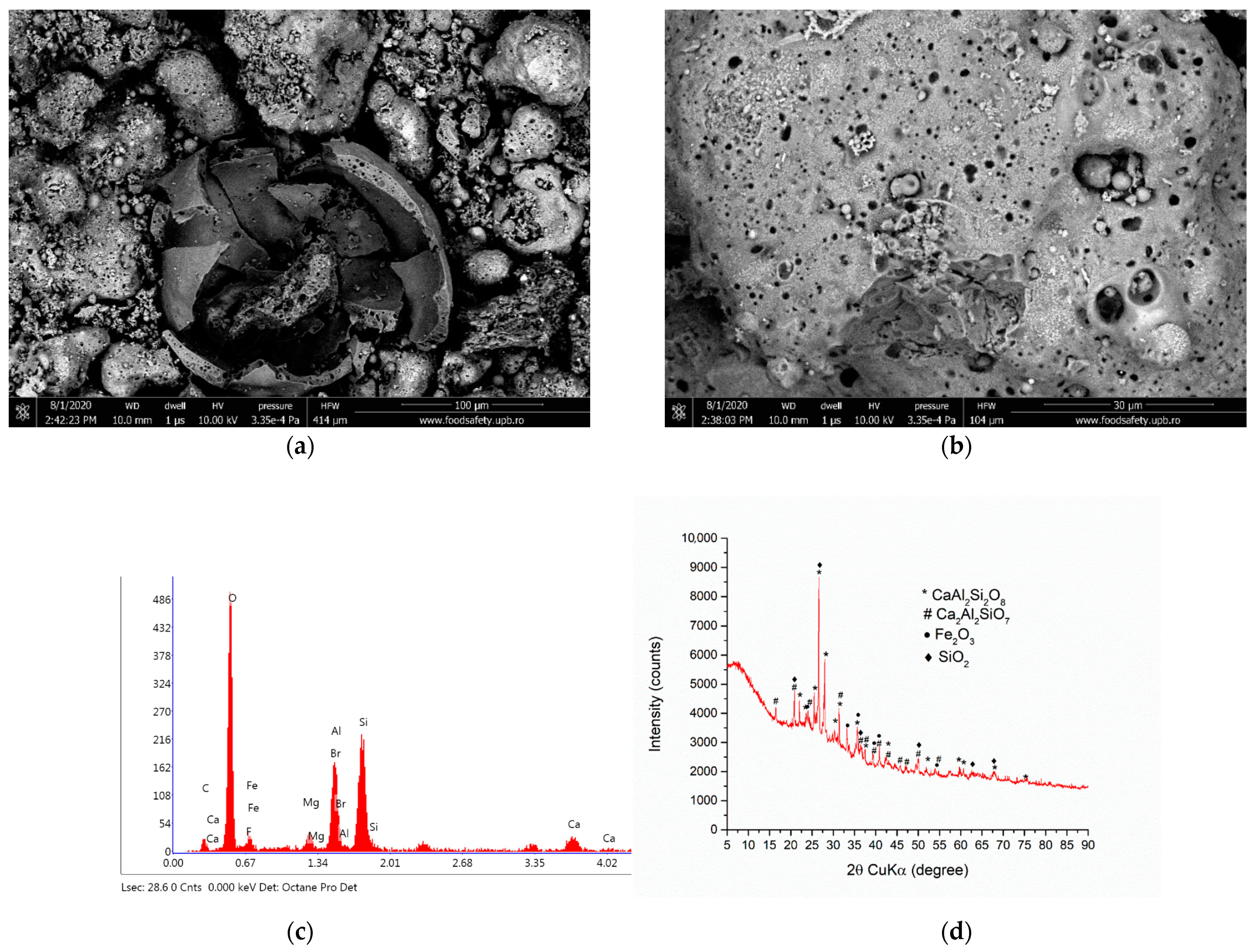
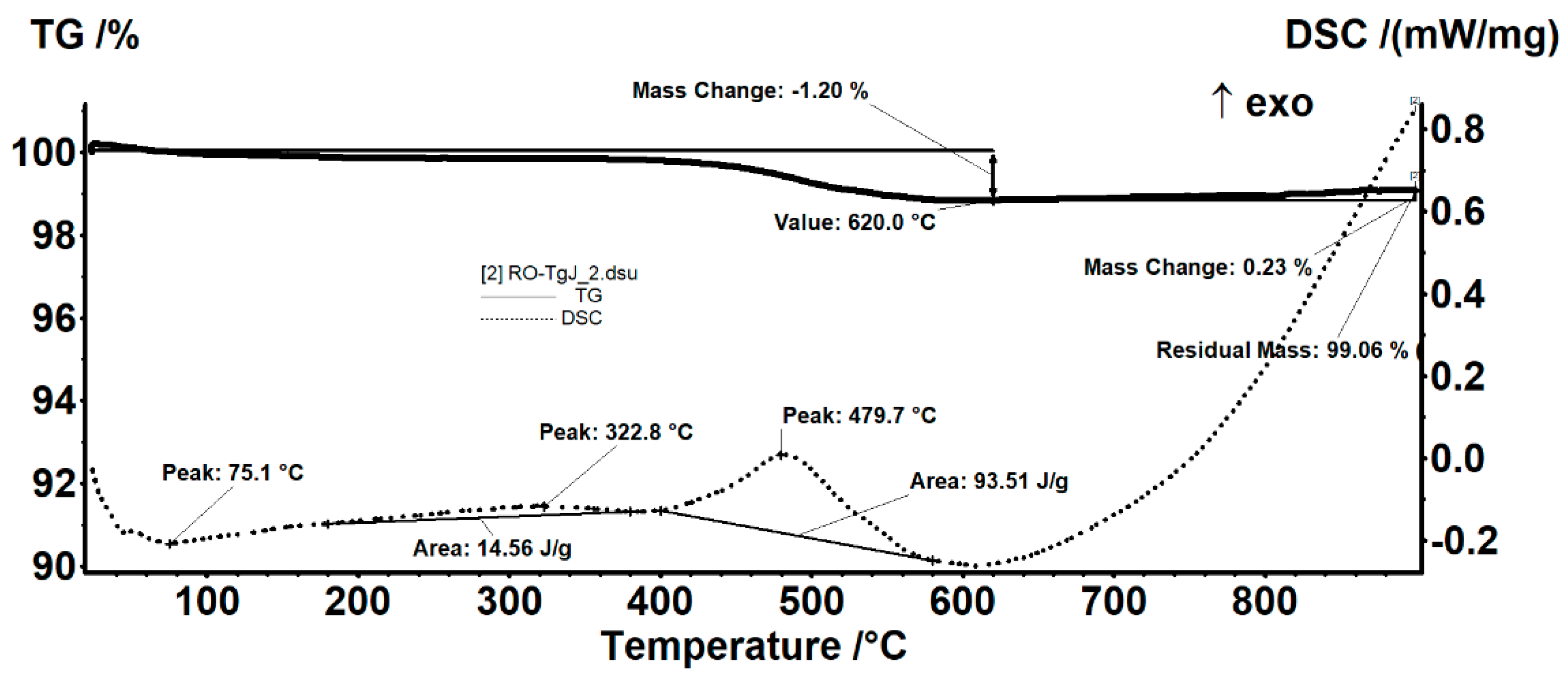



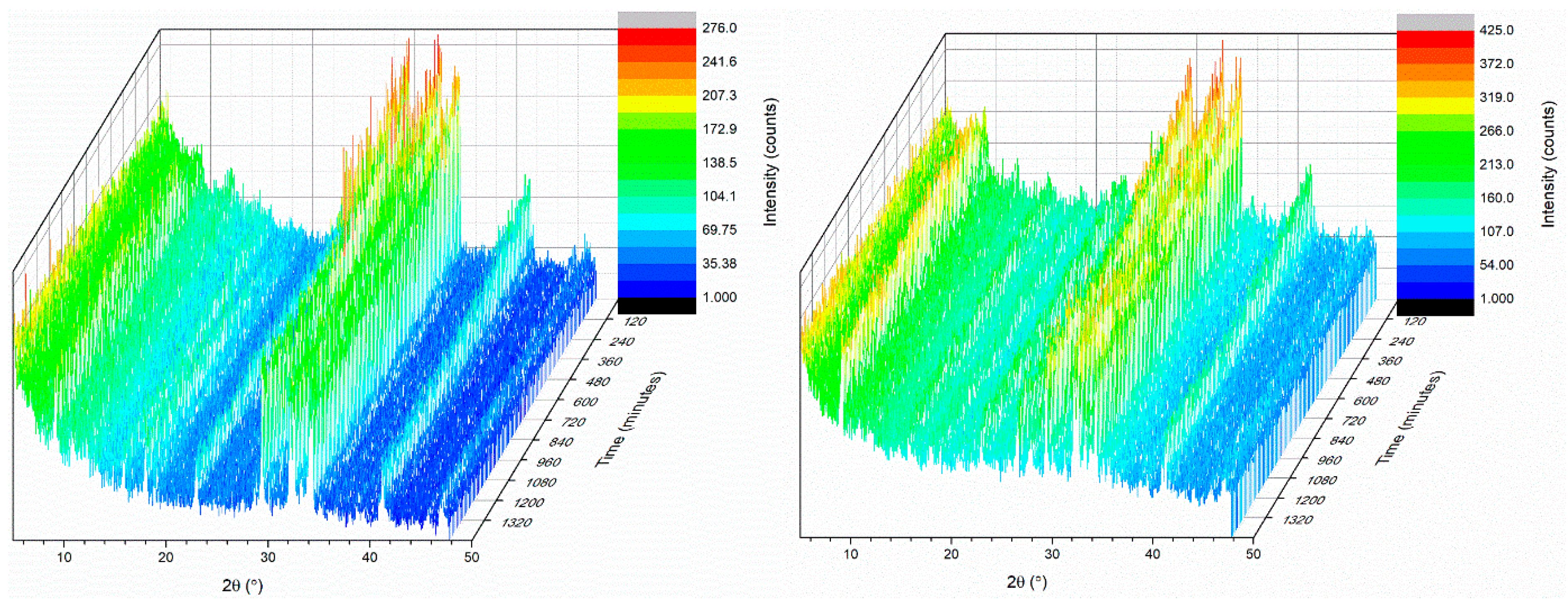
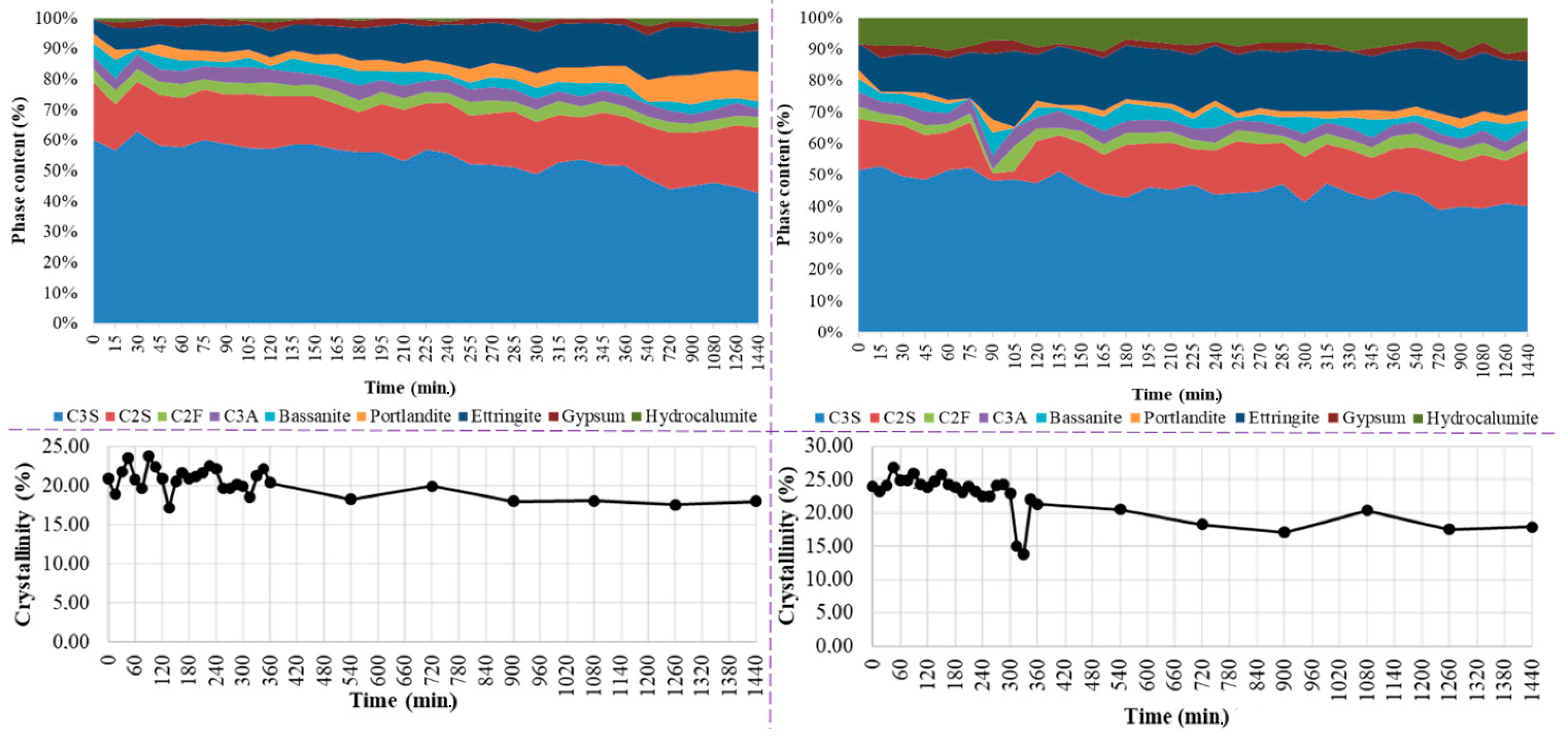

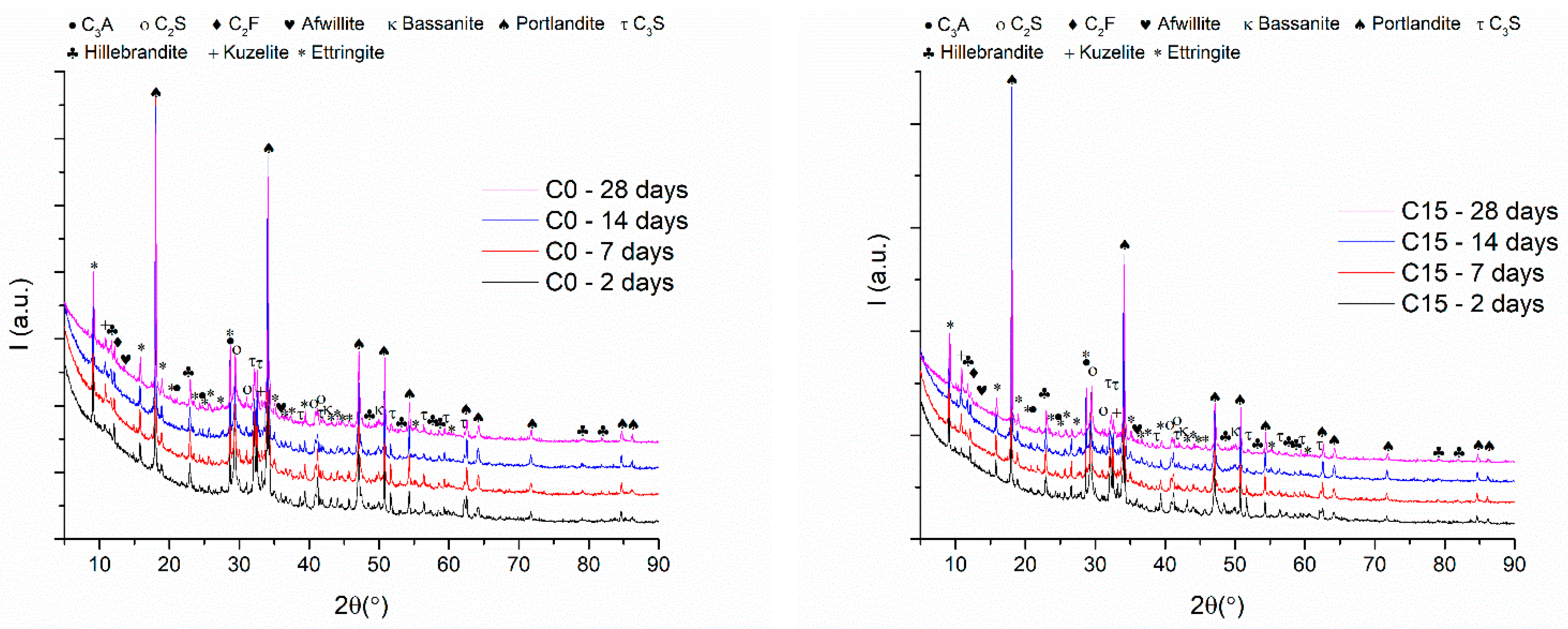

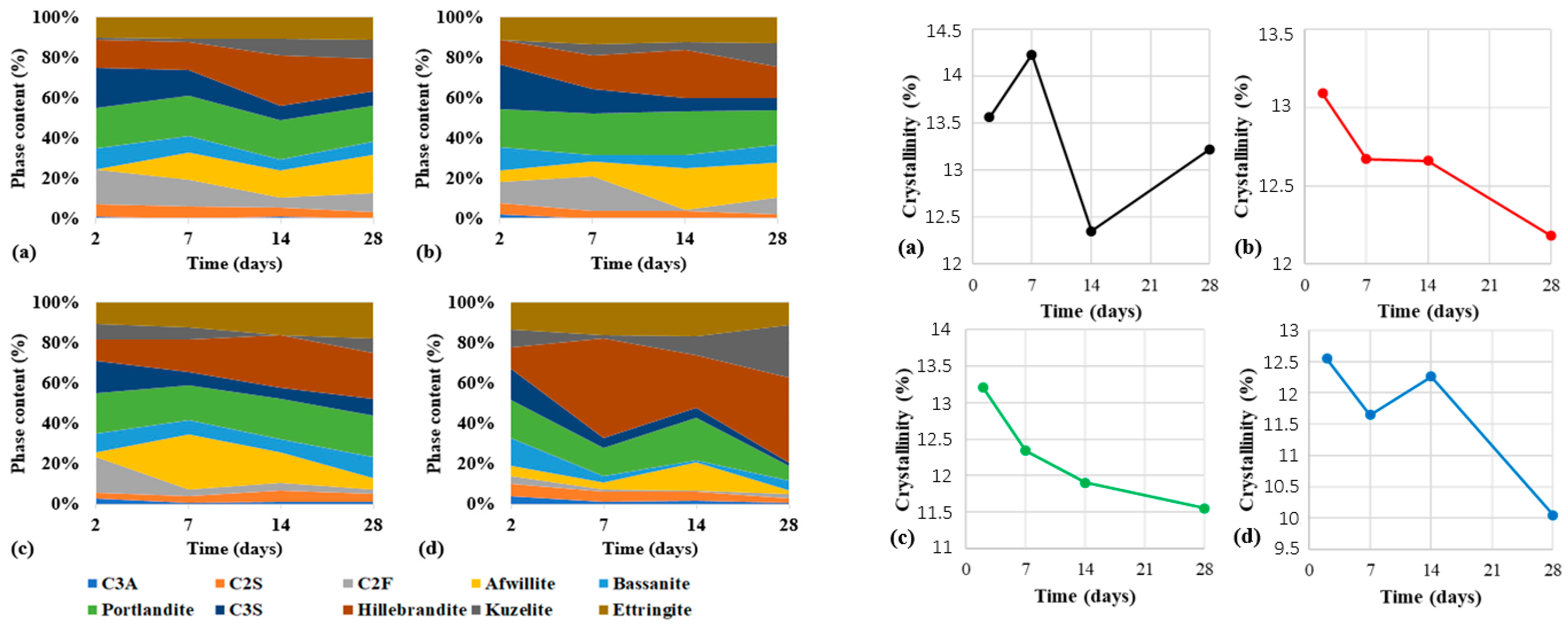
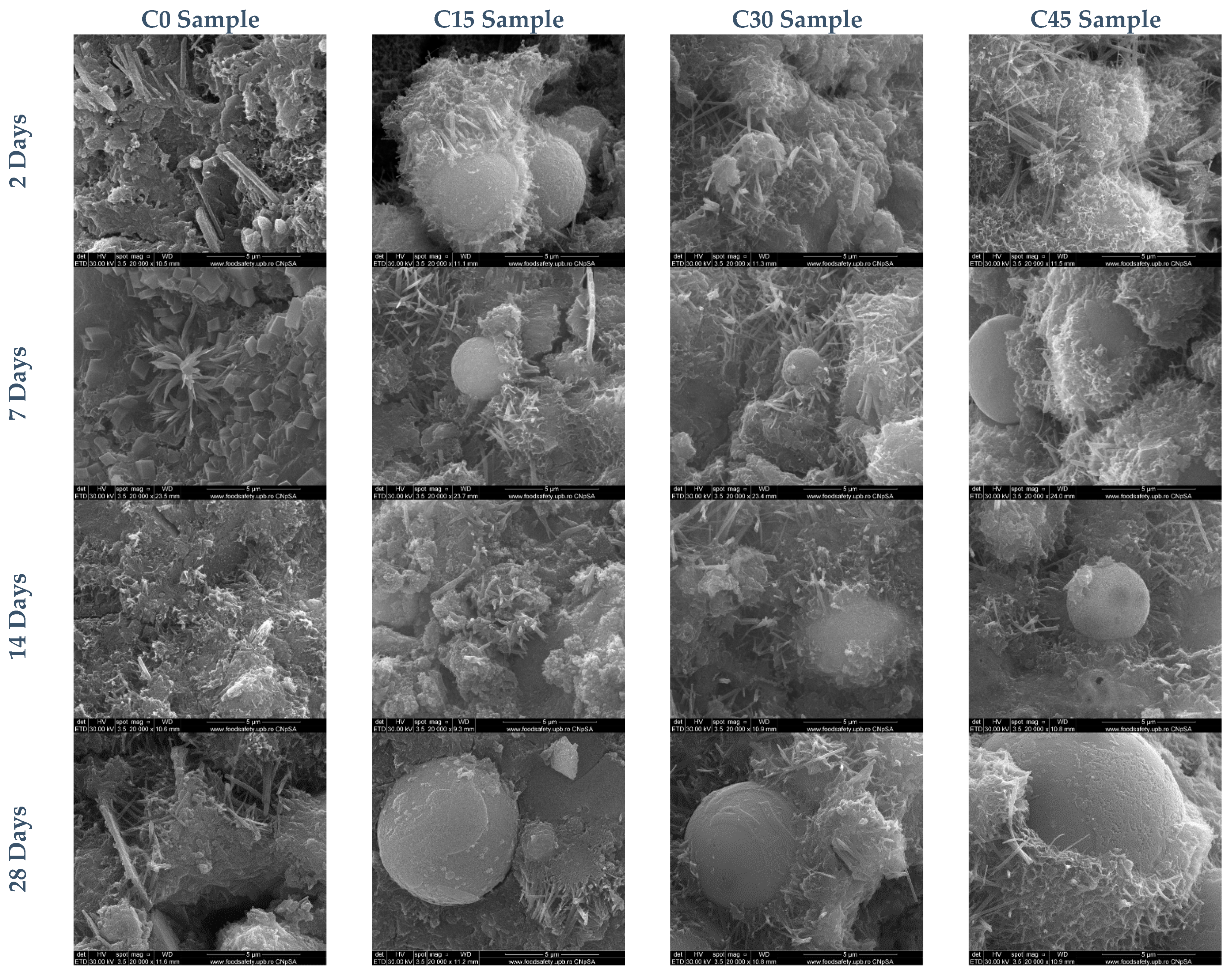




| No. | Ref. Code | Compound Name | Chemical Formula | SemiQuant [%] |
|---|---|---|---|---|
| 1 | 01-075-8322 | Quartz | SiO2 | 31 |
| 2 | 00-041-1486 | Anorthite | CaAl2Si2O8 | 58 |
| 3 | 04-007-6009 | Hematite | Fe2O3 | 4 |
| 4 | 04-015-7930 | Gehlenite | Ca2Al2SiO7 | 7 |
| No. | Reference Code | Compound Name | Chemical Formula |
|---|---|---|---|
| 1 | 00-006-0495 | C3A | Ca3Al2O6 |
| 2 | 00-018-0286 | C2F | Ca2Fe2O5 |
| 3 | 00-020-0452 | Hydrocalumite | Ca2(Al(OH)6)Cl(H2O)2 |
| 4 | 00-036-0617 | Basanite | CaSO4·0.67H2O |
| 5 | 00-055-0738 | C3S | Ca3SiO5 |
| 6 | 04-006-9147 | Portlandite | Ca(OH)2 |
| 7 | 04-011-5267 | Ettringite | Ca6Al2(SO4)3(OH)12(H2O)26 |
| 8 | 04-013-6291 | C2S | Ca2(SiO4) |
| 9 | 00-006-0046 | Gypsum | CaSO4·2H2O |
| Sample Name | Initial Setting Time (hh:mm) | Final Setting Time (hh:mm) |
|---|---|---|
| C0 | 4:27 | 10:42 |
| C15 | 4:56 | 12:23 |
| C30 | 6:32 | 13:12 |
| C45 | 6:20 | 12:36 |
| No. | Reference Code | Compound Name | Chemical Formula |
|---|---|---|---|
| 1 | 00-006-0495 | C3A | Ca3Al2O6 |
| 2 | 00-009-0351 | C2S | Ca2SiO4 |
| 3 | 00-018-0286 | C2F | Ca2Fe2O5 |
| 4 | 00-029-0330 | Afwillite | Ca3(SiO3OH)2·2H2O |
| 5 | 00-036-0617 | Bassanite | CaSO4·0.67H2O |
| 6 | 00-044-1481 | Portlandite | Ca(OH)2 |
| 7 | 00-055-0738 | C3S | Ca3SiO5 |
| 8 | 04-012-1668 | Hillebrandite | Ca2SiO3(OH)2 |
| 9 | 04-013-3303 | Kuzelite | Ca2Al(SO4)0.5(OH)6(H2O)3 |
| 10 | 04-013-3691 | Ettringite | Ca6Al2(SO4)3(OH)12(H2O)26 |
Publisher’s Note: MDPI stays neutral with regard to jurisdictional claims in published maps and institutional affiliations. |
© 2022 by the authors. Licensee MDPI, Basel, Switzerland. This article is an open access article distributed under the terms and conditions of the Creative Commons Attribution (CC BY) license (https://creativecommons.org/licenses/by/4.0/).
Share and Cite
Vasile, B.S.; Nicoara, A.-I.; Surdu, V.-A.; Ene, V.L.; Neacsu, I.A.; Stoica, A.E.; Oprea, O.; Boerasu, I.; Trusca, R.; Vrabec, M.; et al. Fly-Ash Evaluation as Potential EOL Material Replacement of Cement in Pastes: Morpho-Structural and Physico-Chemical Properties Assessment. Materials 2022, 15, 3092. https://doi.org/10.3390/ma15093092
Vasile BS, Nicoara A-I, Surdu V-A, Ene VL, Neacsu IA, Stoica AE, Oprea O, Boerasu I, Trusca R, Vrabec M, et al. Fly-Ash Evaluation as Potential EOL Material Replacement of Cement in Pastes: Morpho-Structural and Physico-Chemical Properties Assessment. Materials. 2022; 15(9):3092. https://doi.org/10.3390/ma15093092
Chicago/Turabian StyleVasile, Bogdan Stefan, Adrian-Ionut Nicoara, Vasile-Adrian Surdu, Vladimir Lucian Ene, Ionela Andreea Neacsu, Alexandra Elena Stoica, Ovidiu Oprea, Iulian Boerasu, Roxana Trusca, Mirijam Vrabec, and et al. 2022. "Fly-Ash Evaluation as Potential EOL Material Replacement of Cement in Pastes: Morpho-Structural and Physico-Chemical Properties Assessment" Materials 15, no. 9: 3092. https://doi.org/10.3390/ma15093092
APA StyleVasile, B. S., Nicoara, A.-I., Surdu, V.-A., Ene, V. L., Neacsu, I. A., Stoica, A. E., Oprea, O., Boerasu, I., Trusca, R., Vrabec, M., Miklavic, B., Sturm, S., Ow-Yang, C., Gulgun, M. A., & Bundur, Z. B. (2022). Fly-Ash Evaluation as Potential EOL Material Replacement of Cement in Pastes: Morpho-Structural and Physico-Chemical Properties Assessment. Materials, 15(9), 3092. https://doi.org/10.3390/ma15093092












